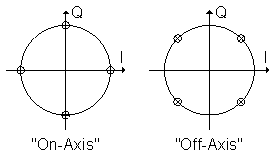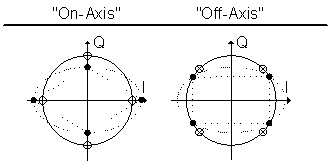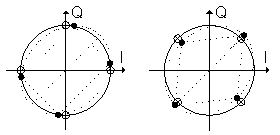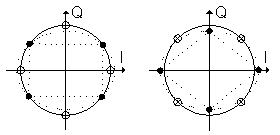IQ Gain Imbalance and Quadrature Skew Error Data Interaction (Custom IQ)
IQ Gain Imbalance and Quadrature Error are defined and evaluated relative to a chosen I/Q reference axis. Often the reference is obvious, such as for 64 QAM Quadrature Amplitude Modulation. For other formats such as 8 PSK Phase Shift Keying: A broad classification of modulation techniques where the information to be transmitted is contained in the phase of the carrier wave., the reference must be established manually or by synchronizing to known data patterns.
A factor in IQ Gain Imbalance and Quadrature Error evaluation is the symbol mapping of a modulator. For example the VSA chooses an "off-axis" mapping of the symbols for QPSK Quadrature phase shift keying, yielding points at (0.707, 0.707), (0.707, -0.707), (-0.707, -0.707), and (-0.707, 0.707). Some modulators may implement QPSK using an "on-axis" mapping of symbols, yielding points at (1.0, 0.0), (0.0, -1.0), (-1.0, 0.0), (0.0, 1.0). In this second case, the symbols¾though estimated correctly¾have a different IQ axis relative to the modulator symbol mapping upon demodulation in the VSA. This is apparent because the constellation diagram has symbol decision points in the "off-axis" locations instead of in the locations used in the modulator mapping as shown in figure 1. This 45° shift of reference affects only the IQ Gain Imbalance Error and Quadrature Error data of the Symbols/Errors table in the VSA.

Figure 1: Two possible constellation mappings for QPSK.
When a signal contains Quadrature skew, the error could be reported as IQ Gain Imbalance if the signal generator has a mapping that is different from the VSA receiver. The reverse is also true. IQ Gain Imbalance is characterized by a gain difference between I and Q channels. This equates to a rectangular stretch along the ideal I/Q axes, once DC offset, phase and amplitude errors have been minimized, as shown in figure 2. Likewise, Quadrature Error is created when the I/Q axes are not exactly 90° apart, leading to a rectangular stretch along a 45° line, as shown in figure 4. When the constellation mapping is incorrect, a 45° rotation is added to the symbols. With a Quadrature Error, the rectangular off-axis stretch is rotated onto the ideal I/Q axes yielding IQ Gain Imbalance. Likewise, the same 45° rotation converts an on-axis rectangular stretch into an off-axis stretch interpreted as Quadrature Error. These results are shown graphically in the differences between figures 4 and 5.
The VSA Digital Demodulation software allows the constellation to be rotated, changing the skew and imbalance calculations. For the example above, a value of 45° will cause the error data to be calculated relative to the "on-axis" mappings. Note the symbol detection locations are rotated with the data but the bit state definitions are relative to the 0° case so bit data output will not change with rotation.

Figure 2: QPSK with IQ Gain Imbalance.

Figure 3: QPSK with Quadrature Error.

Figure 4: QPSK with Quadrature Error, corrected for DC offset, phase, and amplitude errors.

Figure 5: QPSK with Quadrature Error corrected for DC offset, phase, and amplitude errors, but with incorrect state mapping.
For coherent modulation formats, it is recommended to use the rotation parameter with single sweep mode to analyze IQ Gain Imbalance and Quadrature Skew. Averaging does not provide reliable results for IQ Gain Imbalance and Quadrature Error in cases without a consistent phase reference1. This analysis can give information regarding the extent of the problem but if the problem includes both IQ Gain Imbalance and Quadrature Skew isolation of the two error data results is not possible without extended information.
Also note that slight variations in measurement results occur depending on points chosen to be included in the IQ Gain Imbalance and Quadrature Skew algorithms. By default, the VSA software calculates IQ Gain Imbalance and Quadrature Skew using the same point selection as the other measurements.
See Also
